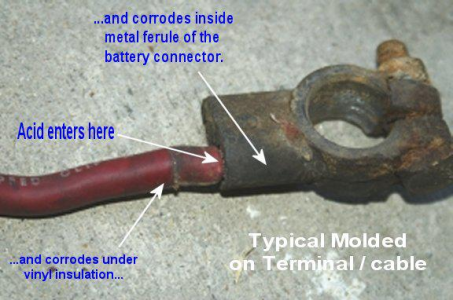Yo 89bronco21x,
Welcome to our Bronco site!
For slow cranking:Inspect for loose battery posts, connectors, cables and visible wire strands & under insulation an inch or so under coonectors:- inspect for corrosion, damage or looseness.- include ground cables from battery post & connector to engine, frame, intake manifold, hood, etc.;- and positive cable from battery to relay to starter.- check starter relay body to inner fender for tightness to a clean, non-rusted/grime -free surface.- check battery for full charge; Voltage; "...a normal battery that is fully charged produces 12.6 volts, not just 12.0 V.
For slow cranking:Inspect for loose battery posts, connectors, cables and visible wire strands & under insulation an inch or so under coonectors:- inspect for corrosion, damage or looseness.- include ground cables from battery post & connector to engine, frame, intake manifold, hood, etc.;- and positive cable from battery to relay to starter.- check starter relay body to inner fender for tightness to a clean, non-rusted/grime -free surface.- check battery for full charge; Voltage; "...a normal battery that is fully charged produces 12.6 volts, not just 12.0 V.
by El Kabong "Cheesy clamp on end. Do not use for a long term repair. Only to get you home when nothing else is available. If you have one of these, suspect it before anything else" El Kabong @
https://www.fullsizebronco.com/forum...lies-faqs.html- use the red and black battery anti-corrosion felt "washers".Slow Cranking or a Grinding Noise; "... Problems with the negative battery cable is a major cause of starting problems in Ford, Lincoln, and Mercury vehicles. Bad battery cables can cause slow cranking or a grinding noise when trying to start an engine. On some late model vehicles, the wire connection inside the battery terminal connector corrodes easily.

miesk5 note, look for greenish corrosion under insulation neat the connector.This will cause a voltage drop in the cable and result in low voltage being supplied to the starter. You can check for voltage drop in the cable using a digital voltmeter. Connect the negative probe of the voltmeter to the negative battery post (not the battery terminal connector). Then connect the positive probe to the starter case and crank the engine. The voltage reading should be less than .5 volts. A higher reading means there is resistance in the cable or the battery terminal connector. Clean the cable end and the battery terminal connector and test again. If the voltage reading is still higher than .5 volts, replace the cable and the battery terminal connector..."Source: by genco1.com"...Why are the cables and battery so important? The starter circuit pulls a lot of amperage, up to 500 amps depending on the starter, the engine load, and battery condition. This kind of amperage stresses all of the components in the starter circuit, including the battery, battery terminals, the cables including the
ground path. Problems with these components are hard to find because they appear fine at rest or under a light load, but generate high resistance under heavy amperage draws. The result will be low voltage to the starter during cranking, resulting in heavier amperage draw and increased internal heat in the starter. Over time, this will cause starter failure. Voltage measured at the starter during cranking should always be above 9.5VDC..."Source: by powermastermotor
Also :
Start engine and run for 10 seconds.
Stop engine and wait 10 seconds.
Start engine and run for 10 seconds.
Stop engine
Remove vacuum hose from pressure regulator.
Examine vacuum hose and port in the pressure regulator for evidence of fuel leakage or aroma through the ruptured diaphragm.
REPLACE regulator
●
See these
1989 Ford Truck Service Manuals - Google Drive
Click "Drive" in pop-up
Includes:
1989 Ford Bronco Electrical & Vacuum Troubleshooting Manual
1989 Bronco & Ford Truck Emissions Manual
1989 Ford Car/Truck Pre-Delivery Manual
1989 Light Duty Truck Volume A: Body/Chassis/Electrical Volume 1 of 2
1989 Light Duty Truck Volume A: Body/Chassis/Electrical Volume 2 of 2
1989 Light Duty Truck Volume B: Engine
●
Haynes Red Manual for 80-95 Bronco & F Series @
Hanes guide 80-96 bko f series.pdf found by BroncMom!
See my mostly recovered site by member schwim @
Ford Bronco And F-150 Links - FORD BRONCO It contains boo-koo component repairs, installation & parts sources.
1989 Ford Bronco Dealer Brochure
1989 Bronco
Lubricant Specifications by Ford via Gary

